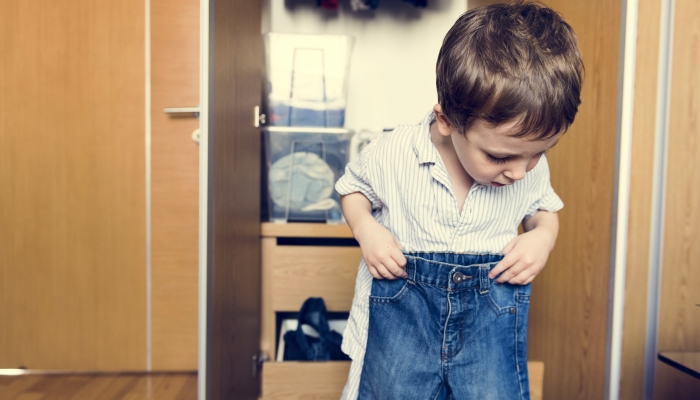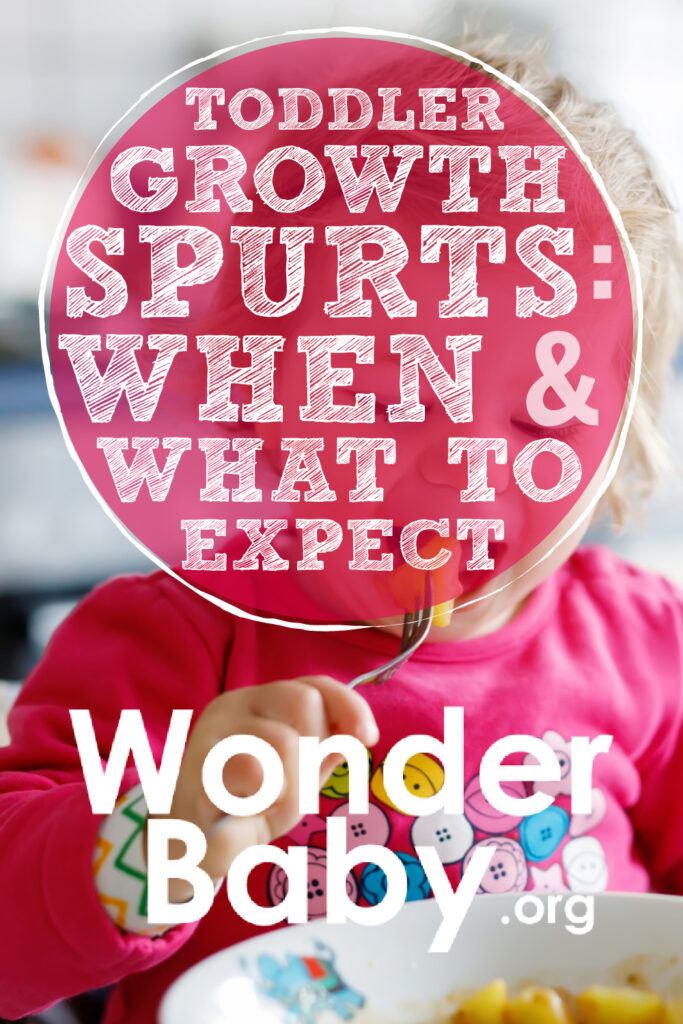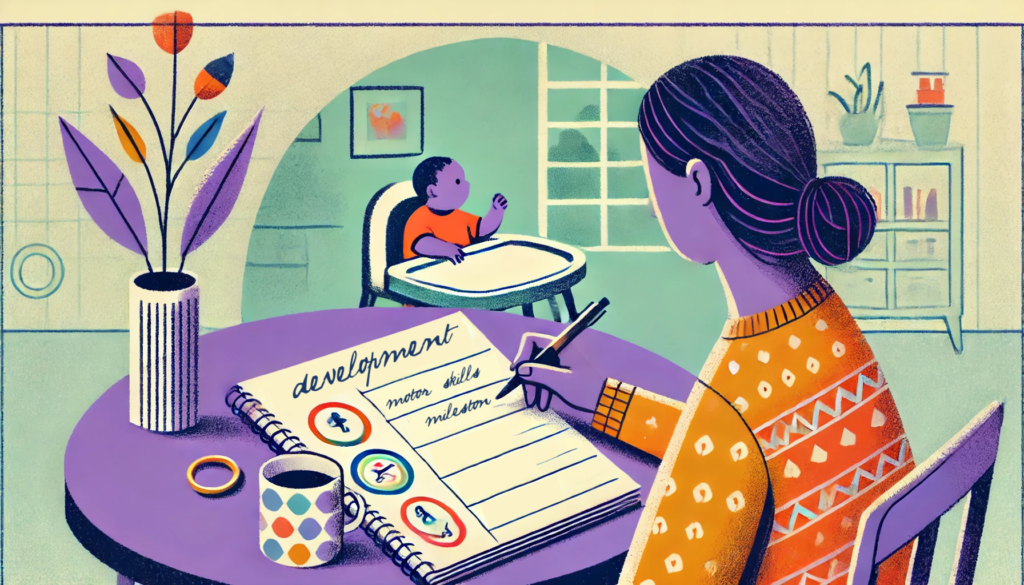Toddler Growth Spurts: When and What to Expect

- Toddler growth spurts occur between one and three years of age.
- The most intense growth spurts happen in the first year of your child’s life and when they reach puberty.
- While a toddler growth spurt may not be as dramatic as these other stages, this is the period when your little one develops from a baby into a child.
- You’ll notice your toddler growing taller and bigger during this time. Alongside this, their brain is growing at an astonishing rate—more in these first three years of life than at any other point.
- Predictable patterns of growth and development happen during the toddler years but there’s a huge variation in when they occur. Your toddler is unique and will grow and develop at their own pace.
During their first year of life, your baby grows incredibly fast. They may have tripled their birth weight and grown an additional 9 to 10 inches by their first birthday. From this point on, their growth slows down until the next period of rapid growth kicks in at puberty.
While your toddler’s growth slows down in comparison to that first year, between the ages of one and three, your child continues to grow at a steady pace. You’ll see amazing advances in your toddler’s speech and language, mobility and cognition, those all-important thinking skills.
A lot is going on for your toddler during this time, and your support is vital to give them the best start in life. So, let’s find out more about toddler growth spurts and how you can help.
Toddler Growth Spurt: When Does It Happen?
The term toddler describes babies aged one to three years old, regardless of when they toddle. During the toddler stage, a lot of growth spurts and development occur but it’s difficult to predict exactly when they’ll happen for your child. All toddlers grow and reach developmental milestones on their own timeline.
In the first year, your baby shows significant growth and development every two to four weeks. After a year, this slows to roughly every three months until the age of two, when it slows to six months. From six into adulthood, these intervals of change lengthen to around a year.
This doesn’t mean your baby stays the same the rest of the time, but it can be reassuring to know that change is never far away. It can also help to know that development isn’t linear.
Research reveals that your child’s development looks more like a spiral where they cycle through phases of rapid development (disequilibrium) and times when life is calmer (equilibrium).
This explains why your child may seem to lose existing skills when working on new ones. Often skills are temporarily mislaid until your child’s busy brain has adapted to new learning, only to return once the growth spurt has passed.
Busy times for development often occur around 18 months and 2½ years, but try not to compare your toddler with others of the same age, as there’s a wide variation in when children grow and pick up specific skills.

What Factors Affect Toddler Growth Spurts?
During pregnancy and the first year, most growth spurts are triggered by the quality of diet and nutrition. Once your child is a toddler, a good diet is still vital for healthy growth and development but other factors also play a significant role:
Physical factors
Genes, personality, and temperament all affect normal growth and development along with certain medical conditions, including heart and kidney issues, hypothyroidism, and food allergies.
As well as a healthy diet, your child needs a safe place to play and rest. Play is the primary source of your toddler’s learning, and sleep is literally when your child grows, as this is when growth hormone is released.
Stress
In small amounts, stress is healthy. It motivates your child to learn, builds resilience, and even boosts immunity. However, too much stress isn’t good for anyone.
Young children are especially sensitive to stress. Their emotional brains are hot-wired for survival at this age and are prone to strong reactions. There’s only so much brain power available, so what’s tied up with stress isn’t available for growth and development.
Relationships
The good news is that feeling loved and supported protects your child from the harmful effects of stress and influences how physical factors, like genes, impact growth and development. Building your relationship with your child is your most important job as a parent.

How to Tell If Your Toddler Is Experiencing a Growth Spurt
You may only realize your toddler is going through a growth spurt once you look back on their recent behavior. During a growth spurt your toddler may be:
- Tired. You might notice your toddler sleeping a lot or seeming more tired than usual. Offer plenty of opportunities to rest and lots of physical activity and time outside to help them fall asleep.
- Hungry. In order to gain weight and fuel physical changes, toddlers tend to need more calories. Offer a varied healthy diet.
- Craving particular foods. Toddlers often favor particular foods; sometimes this can be related to a need for specific vitamins and minerals. Try not to worry if your child wants to eat the same thing again and again. Keep offering a variety of healthy foods and look at their diet throughout the week rather than stressing about individual days.
- Outgrowing clothes and shoes. This may be one of the first signs of a recent growth spurt. Remember your child’s limbs are catching up with all that baby growth. Keep one step ahead with a few items of the next size on hand.
- Demonstrating new skills. Your child is growing so fast, you’re bound to see lots of progress, especially in language and motor skills. Encourage those sensory motor skills with age-appropriate toys and lots of loving attention. Find ways to enjoy spending time together and keep chatting to help build those reciprocal conversation skills.
- More clumsy than usual. With so many new skills, it can take a while to master them all. Plus, those growing limbs can make coordination a challenge. Give your child plenty of time and space to play, both indoors and out.
- Experiencing growing pains. We don’t know why some children wake up with dull aches and pains in their legs, but these so-called growing pains can be uncomfortable and affect your toddler’s sleep. They usually last for less than 20 minutes, may follow particularly busy days, and sometimes re-occur for a few nights in a row. A warm bath might help, along with some stretching, massage, hugs, and lots of reassurance.
- Emotional. You may notice your toddler seems more emotional and moody. Remember all of these rapid changes are bound to take their toll. Be kind and patient with your clingy toddler and if they show signs of aggression, stay close, keep everyone safe and focus on finding healthy ways to express feelings.
How Much Should Your Toddler Grow?
Between the ages of one and three, your toddler will grow around 7–8 inches and weigh an additional 11 pounds. By the end of their third year, your child will have quadrupled their birth weight and may be halfway to their adult height.
These figures are based on average growth, so your child may grow more or less than this and still be well within the range of normal. Your child’s healthcare provider will check their height and weight against standard growth charts from the World Health Organization (WHO).
These growth charts show recommended patterns of growth for children who have been breastfed, at least most of the time, for four months and still breastfeeding at 12 months. The WHO recommends breastfeeding up to the age of two years and beyond.
If your toddler is eating a healthy diet and seems well yet isn’t growing much, remember the influence of genes on your child’s height and weight. If your baby has short parents, then it’s likely they too will be shorter, and if they have taller parents, they are more likely to be tall.
At around six months some babies start to dip below-average on their growth chart. This growth delay seems to affect more boys than girls and may be genetic. For most, their physical development catches up between 18 months and 2 years and they become average-height adults.

How Long Does a Toddler Growth Spurt Last?
During their first year, your baby’s growth spurts were frequent and dramatic but only lasted up to three days. Your toddler’s growth spurts are less intense but may last for more than a week at a time.
Much of this growth and development is gradual or hidden so you may not notice your child’s growth spurt until afterward. Consider, for instance, that your child will speak around 500 words at the age of three, yet they can understand thousands more.
So much learning, along with all that physical growth takes a lot of effort and resources. It’s also important to remember that your toddler’s emotional development is lagging behind the other progress you see. In a recent survey, researchers discovered that many parents have unrealistic expectations of their toddlers in areas like sharing and impulse control.
Between the ages of four and six, there are giant leaps in emotional maturity, but development continues well into the early 20s. So when your toddler experiences big reactions and finds it hard to cope with the events of the day, these are normal, age-appropriate responses, even when they seem so mature in other areas.
Your child has a lot of emotional learning to do and how you respond to them at this age is a powerful model for how they will act in the future. Be kind and patient, try not to worry too much, and enjoy this time with your little one. Remember, your patience and understanding will go a long way to making this time much more pleasant and peaceful for you both.
FAQs
Do toddlers get tired during growth spurts?
Yes. There is so much going on in their body and brain during a growth spurt that children tend to need more sleep and often for longer periods. Although it can also be the case that your toddler finds it harder to sleep with such a busy brain. Make sure you get plenty of rest and take care of yourself so you can offer your child the support they need.
Who tends to have growth spurts first: girls or boys?
When it comes to puberty, on average this begins earlier for girls than boys. During early childhood though, there is no significant difference. Your child’s growth spurts will happen at the time and pace that’s right for them.
When should I consult my healthcare provider?
If your child seems active and happy, yet isn’t growing as fast as other children, there’s probably nothing to worry about—but you know your child best. Trust your instincts, and if you are at all concerned about your child’s growth and development, don’t hesitate to get advice.

The information WonderBaby provides is not intended to be, and does not constitute, medical or other health advice or diagnosis and should not be used as such. Always consult with a qualified medical professional about your specific circumstances.
Related Posts

Development, Special Needs
How to Track Milestones for Developmentally Delayed Babies
Parents of developmentally delayed babies can explore practical tools and strategies to track milestones, celebrate progress, and support their child’s unique developmental journey.

Fine and Gross Motor
5 Alternatives to Tummy Time for Babies with Motor Development Challenges
Does your baby struggle with tummy time due to motor development challenges? These alternatives to tummy time will offer the same benefits.

Development
Should Twins Share a Room?
Wondering if your twins should share a room? We’ll explore the pros and cons of room-sharing for twins right here before you make your decision.